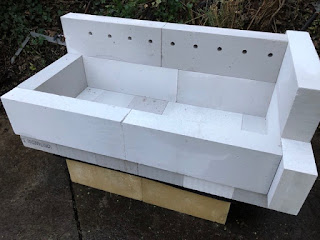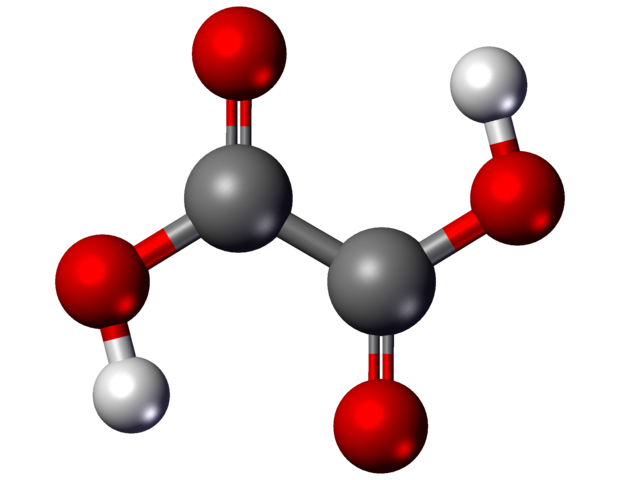Science warning: this post contains actual science. You have been warned...
I mentioned in a
previous post that I would go into some more detail about
Varroa treatments. The first one - and the one usually applied in winter, is
oxalic acid. But what is it?
Before we get to that, a quick reminder of how atoms work. They consist of a nucleus, which contains one or more protons - each of which has a positive electric charge. The nucleus usually contains neutrons too - but we don't need to worry about that right now. The other component of the atom is electrons - each atom has one or more of these, and they are negatively charged. The nucleus is at the centre of the atom, with the electrons round the outside, which is why schools often teach that atoms are like mini-solar-systems. (Proper physicists can explain - at length - why that isn't actually true. But we don't need to worry about that today, either.) Now, molecules are basically two or more atoms stuck together in a particular way. All clear so far? Good - onto
oxalic acid:
Firstly, it's an
organic acid. Let's look at what that means.
Organic has a (somewhat) specific meaning in chemistry - it means that each molecule of the chemical contains the elements carbon and hydrogen, and that it (usually) contains a carbon-hydrogen bond. This, in turn, means that the molecule contains a join between at least one carbon atom and at least one hydrogen atom, and this is a covalent bond - which means that the bond is formed by the hydrogen atom sharing its electron with the carbon atom.
However, this definition is a little arbitrary, because there are certain organic chemicals that contain carbon but lack a carbon-hydrogen bond. And, wouldn't you know it, oxalic acid just happens to be one of these exceptions. So, oxalic acid is organic because basically chemists say it is.
Secondly, oxalic acid is an
acid. An acid (strictly speaking, a
Brønsted acid) is a chemical which has a molecule that is structured such that it can donate one or more protons to another molecule. A proton is a hydrogen nucleus - in other words, a hydrogen atom but without its electron. And oxalic acid belongs to a group called the
dicarboxylic acids, which (to simplify somewhat) means that it can donate two protons. This then gives the molecule two negative electric charges (because it has donated the protons - the hydrogen nuclei - but kept the two electrons from the hydrogen). It is the donation of the two protons, and the resulting double-negative charge, that makes the oxalic acid chemically reactive, and makes it an acidic reaction.
Oxalic acid was originally isolated from wood-sorrel (Latin genus name
Oxalis). Fun fact - it occurs in relatively high concentrations in rhubarb leaves, which has given rise to the idea that women used to slowly murder their husbands by feeding rhubarb leaves to them.
So,
why oxalic acid? Well, it's no coincidence that it occurs naturally in wood-sorrel, rhubarb, and lots of other plants. They have evolved the production of oxalic acid, particularly in their leaves, to discourage invertebrates and larger animals from eating them. So, from this we know that it's toxic to invertebrates - which includes insects and arachnids.
The
Varroa mite is an arachnid - which means that it is susceptible to oxalic acid poisoning. The actual mode of action is interesting. The acid is applied by first dissolving in a 1:1 (by weight) sugar syrup, to create a solution that is 4.2% oxalic acid. This is then trickled into the hive, so that it falls onto the bees between the frames of wax comb. It appears the bees don't tend to consume much of the liquid (though there are different studies with different data about this). What does happen is, as the bees move around the hive, the oxalic acid solution gets spread around on their bodies, and gets smeared into smaller and smaller droplets.
Once the droplets are small enough, the water evaporates off leaving sugar and oxalic acid crystals. The sugar isn't important, but the oxalic crystals are. They are now on the bees' bodies, which is also where the
Varroa mites are. As they walk around on the bees, the mites pick up oxalic crystals on their feet. The crystals then dissolve on the feet of the mites. What happens next depends on which study you read.
One version says that the oxalic acid damages the mites' feet (strictly speaking, the cuticles at the end of the legs), causing them to lose their grip on the host bee and fall off. This happens because the mites' feet are made of chitin, which is a long-chain polymer similar to cellulose. The polymer chains are held together by hydrogen bonds (sorry, more chemistry), which are held together by electrostatic forces. Remember that oxalic acid works by donating positively-charged protons and thereby becoming negatively charged. All this positive-negative charge jiggery-pokery interferes with the hydrogen bonds, which causes the chitin polymer chains to separate from each other, irreparably damaging the feet of the mite.
The other version is that the oxalic acid is absorbed through the mites' feet and travels through the haemolymph (the internal liquid they have instead of blood). The exact effect of the toxicity is not clear - although damage to the mites' mouthparts has been reported. Since these are also made of chitin (as are pretty much all hard parts of the mite) it may well be the acid's interference in the hydrogen bonds that causes
Varroa mite mortality.
While a 4.2% solution of oxalic acid is at too low a concentration to cause much harm to adult honey bees, there is some evidence that it can damage brood. Also, oxalic acid treatment only affects mites that are on the adult bees (known as the
phoretic stage) - not the mites that are in the brood cells with the larvae. For both these reasons, it is therefore best to undertake oxalic acid treatment when the hive has little or no brood. The colder the weather, and the shorter the daylight hours, the less brood there will be in the colony. Which is why most beekeepers tend to treat between the winter solstice and the end of the year. And why I was out on a cold December day over the Christmas holidays,
dribbling oxalic acid solution into my hives.
There is another organic acid that is also used as an anti-
Varroa treatment, which we'll look at next time.
































